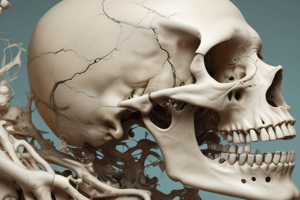Podcast
Questions and Answers
What is osteoporosis primarily caused by in individuals after midlife?
What is osteoporosis primarily caused by in individuals after midlife?
- Excessive bone formation
- Increased osteoblast activity
- Increased osteoclast activity (correct)
- Hormonal balance
What is the primary function of osteoblasts in bone tissue?
What is the primary function of osteoblasts in bone tissue?
- To maintain mineral homeostasis
- To initiate osteoclast activity
- To form new bones (correct)
- To dissolve damaged bone
Which component is essential for the mineralization process in bone formation?
Which component is essential for the mineralization process in bone formation?
- Osteoprotegerin
- Hydroxyapatite
- Calcium and phosphorus (correct)
- Collagen
How does estrogen hormone help in maintaining bone strength?
How does estrogen hormone help in maintaining bone strength?
What are trabeculae?
What are trabeculae?
What is the role of osteoprotegerin in bone resorption?
What is the role of osteoprotegerin in bone resorption?
Which type of bone comprises the pectoral girdle?
Which type of bone comprises the pectoral girdle?
What process describes the laying down of new bone material?
What process describes the laying down of new bone material?
What type of ossification is responsible for forming the flat bones of the skull?
What type of ossification is responsible for forming the flat bones of the skull?
Which of the following bones is primarily formed through endochondral ossification?
Which of the following bones is primarily formed through endochondral ossification?
Which type of joint allows for the most movement?
Which type of joint allows for the most movement?
The acetabulofemoral joint is formed by the articulation of which two bones?
The acetabulofemoral joint is formed by the articulation of which two bones?
What is a characteristic of synarthrosis joints?
What is a characteristic of synarthrosis joints?
Which type of joint connects bones using dense regular connective tissue rich in collagen fibers?
Which type of joint connects bones using dense regular connective tissue rich in collagen fibers?
Which joint includes three articulations known as the humeroradial joint, humeroulnar joint, and proximal radioulnar joint?
Which joint includes three articulations known as the humeroradial joint, humeroulnar joint, and proximal radioulnar joint?
Which of the following bones is considered part of the appendicular skeleton?
Which of the following bones is considered part of the appendicular skeleton?
What is the primary function of the skeletal system regarding the body's internal framework?
What is the primary function of the skeletal system regarding the body's internal framework?
Which part of the long bone is known as the diaphysis?
Which part of the long bone is known as the diaphysis?
What role do skeletal muscles play in conjunction with the bones?
What role do skeletal muscles play in conjunction with the bones?
Which type of bone formation occurs at the epiphyseal plate in children?
Which type of bone formation occurs at the epiphyseal plate in children?
Which mineral is primarily stored in bones and is crucial for maintaining bone mass?
Which mineral is primarily stored in bones and is crucial for maintaining bone mass?
What is the main risk factor for developing osteoporosis?
What is the main risk factor for developing osteoporosis?
In adults, what replaces the growth plate at the ends of long bones when growth has stopped?
In adults, what replaces the growth plate at the ends of long bones when growth has stopped?
What type of fat is primarily stored in the medullary cavity of long bones?
What type of fat is primarily stored in the medullary cavity of long bones?
Flashcards are hidden until you start studying
Study Notes
Functions of the Skeletal System
- Provides shape and support to arms and legs.
- Maintains mineral homeostasis in the body.
Bone Cells and Bone Formation
- Osteoblasts: Build new bones; synthesize and secrete bone matrix.
- Osteoclasts: Dissolve old or damaged bone; essential for bone remodeling.
- Ossification (osteogenesis): Process of new bone material formation by osteoblasts; integral to bone remodeling.
- Bone structure includes:
- Compact bone: Dense outer layer.
- Cancellous (spongy) bone: Contains trabeculae, thin interlocking plates.
- Bone remodeling requires physical stress and calcium level changes in the blood.
- Osteoblasts promote the maturation of osteoclasts through cytokine release.
- Osteoclasts use enzymes for bone resorption, while osteoblasts release osteoprotegerin to inhibit further resorption.
- Minerals like calcium and phosphorus, along with collagen, form hydroxyapatite, solidifying bone structure.
Bone Remodeling and Hormonal Influence
- Balance between bone resorption and formation is maintained until midlife.
- Estrogen reduces osteoclast activity; its decline post-midlife contributes to osteoporosis.
- Osteoporosis results in weakened bones, thinner trabeculae, and increased fracture risk.
Types of Ossification
- Intramembranous Ossification: Forms flat bones of the skull, face, jaw, and central clavicle through sheet-like layers.
- Endochondral Ossification: Transforms cartilage into bone; forms most body bones, especially long bones.
Articulations (Joints)
- Joints are formed where two or more bones meet.
- Specific examples include:
- Acetabulofemoral joint: Hip joint; acetabulum articulates with femur head.
- Glenohumeral joint: Shoulder joint; glenoid cavity articulates with humerus head.
- Joints can involve multiple articulations (e.g., knee includes tibiofemoral and patellofemoral joints; elbow involves three articulations).
- Joints classified by functional movement:
- Synarthrosis: No mobility (e.g., sutures of the skull).
- Amphiarthrosis: Slight mobility (e.g., intervertebral discs).
- Diarthrosis: Freely movable joints (e.g., synovial joints).
- Structural classification based on connecting tissue:
- Fibrous joint: Bones connected by dense regular connective tissue.
Specific Functions of the Skeletal System
- Support: Provides framework to support body and organs (e.g., rib cage).
- Protection: Shields soft organs from injury.
- Movement: Skeletal muscles use bones as levers for body movement.
- Blood Cell Formation: Occurs in the marrow.
- Storage:
- Fat is stored in various body areas, including bone marrow (70% of adult marrow volume).
- Calcium and phosphorus crucial for maintaining bone mass.
Classification of Bone Tissue
- Bone tissue retains critical minerals including 90% of body's phosphorus, important for kidney function and muscle recovery.
Types of Bones
- Human skeleton contains 206 bones categorized into four shapes:
- Long bones: Include femur, characterized by a diaphysis and epiphyses.
- Growth Plates: Hyaline cartilage present in children/adolescents; replaced by epiphyseal lines in adults.
- Metaphysis: Area between the growth plate and diaphysis essential for load transfer.
Long Bone Structure
- Diaphysis: Shaft of long bone.
- Epiphysis: Expanded ends of long bones.
- Medullary Canal: Central cavity housing red and yellow bone marrow.
- Long bones grow at their epiphyseal ends, not from the center outward.
Studying That Suits You
Use AI to generate personalized quizzes and flashcards to suit your learning preferences.





